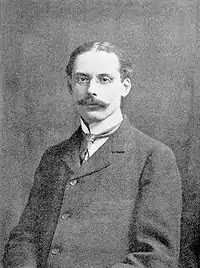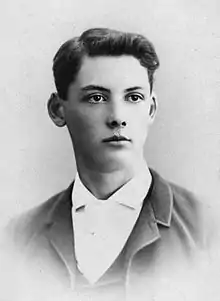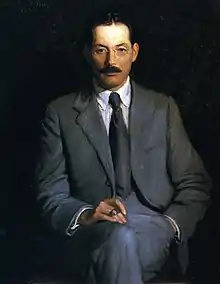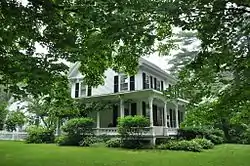Edwin Arlington Robinson | |
|---|---|
 | |
| Born | December 22, 1869 Head Tide, Maine, U.S. |
| Died | April 6, 1935 (aged 65) New York City, New York, U.S. |
| Occupation |
|
| Education | |
| Period | 1896–1935 |
| Notable awards | Pulitzer Prize for Poetry (1922; 1925; 1928) |
| Partner | Elizabeth Sparhawk-Jones |
| Relatives | David S. Nivison (grandnephew) |
| Signature | |
Edwin Arlington Robinson (December 22, 1869 – April 6, 1935) was an American poet and playwright. Robinson won the Pulitzer Prize for Poetry on three occasions and was nominated for the Nobel Prize in Literature four times.[1]
Early life
Robinson was born in Head Tide, Maine on December 22, 1869.[2] His parents were Edward and Mary (née Palmer). They had wanted a girl, and did not name him until he was six months old, when they visited a holiday resort—at which point other vacationers decided that he should have a name, and selected the name "Edwin" from a hat containing a random set of boy's names. The man who drew the name was from Arlington, Massachusetts, so "Arlington" was used for his middle name.[3] Throughout his life, he hated not only his given name but also his family's habit of calling him "Win". As an adult, he always used the signature "E. A."[4]
Robinson's family moved to Gardiner, Maine, in 1870. He later described his childhood as "stark and unhappy".[2] Robinson first studied at Mrs. Morrell's School in Gardiner and later attended public schools, graduating from Gardiner High School.[4]
Robinson's early struggles led many of his poems to have a dark pessimism and his stories to deal with "an American dream gone awry."[5] His eldest brother, Dean, was a doctor and had become addicted to laudanum while self-medicating for neuralgia.[6] The middle brother, Herman, a handsome and charismatic man, married the woman Edwin loved, Emma Löehen Shepherd.[7] Emma thought highly of Edwin and encouraged his poetry,[7] but he was deemed too young to be in realistic competition for her hand, which didn't keep him from being agitated deeply by witnessing what he considered her being deceived by Herman's charm and choosing shallowness over depth.[6] The marriage was a great blow to Edwin's pride, and during the wedding ceremony, on February 12, 1890, the despondent poet stayed home and wrote a poem of protest, "Cortège", the title of which refers to the train that took the newly married couple out of town to their new life in St. Louis, Missouri.[4] Herman suffered multiple business failures, becoming an alcoholic, and ended up estranged from his wife and children. Herman died impoverished in 1909 of tuberculosis at Boston City Hospital. Robinson's poem Richard Cory was thought by his sister-in-law Emma to refer to her husband.[8]
Education at Harvard University

In 1891, at the age of 21, Robinson entered Harvard University as a special student. He took classes in English, French, and Shakespeare, as well as one on Anglo-Saxon that he later dropped. He did not aim to get all A's; as he wrote his friend Harry Smith, "B, and in that vicinity, is a very comfortable and safe place to hang."
Robinson's real desire was to get published in one of the Harvard literary journals. Within the first fortnight of being there, The Harvard Advocate published Robinson's "Ballade of a Ship." He was even invited to meet with the editors, but when he returned, he complained to his friend Mowry Saben, "I sat there among them, unable to say a word."
Robinson's father died after his first year at Harvard. He returned to Harvard for a second year, but it was to be his last one as a student there. Though short, Robinson's stay in Cambridge included some of his most cherished experiences, and there he made his most lasting friendships. He wrote his friend Harry Smith on June 21, 1893:
I suppose this is the last letter I shall ever write you from Harvard. The thought seems a little queer, but it cannot be otherwise. Sometimes I try to imagine the state my mind would be in had I never come here, but I cannot. I feel that I have got comparatively little from my two years, but still, more than I could get in Gardiner if I lived a century.
By mid-1893, Robinson had returned to Gardiner, where he made plans to start writing seriously. In October he wrote his friend Gledhill:
Writing has been my dream ever since I was old enough to lay a plan for an air castle. Now for the first time I seem to have something like a favorable opportunity and this winter I shall make a beginning.
Career

With his father gone, Robinson became the man of the household. He tried farming and developed a close relationship with his sister-in-law Emma Robinson, who after her husband Herman's death, moved back to Gardiner with her children. She twice rejected marriage proposals from Robinson, after which he permanently left Gardiner. He moved to New York, where he lived as an impoverished poet while cultivating friendships with other writers, artists, and intellectuals. In 1896, he self-published his first book, The Torrent and the Night Before, paying 100 dollars for 500 copies. Robinson meant it as a surprise for his mother. Days before the copies arrived, his mother died of diphtheria. His eldest brother, Dean, died of a drug overdose in 1899.[4]
Robinson's second volume, Children of The Night, published in 1897, had a somewhat wider circulation. Its readers included President Theodore Roosevelt's son Kermit, who had received a copy from his teacher, who happened to be a friend of Robinson. Kermit then recommended it to his father, who, impressed by the poems and aware of Robinson's straits, invited Robinson to join him for dinner at the White House (though Robinson declined due to his lacking "suitable clothes")[9] and in 1905 offered the writer a sinecure at the New York Customs Office. According to Edmund Morris, author of Theodore Rex, a tacit condition of his employment was that, in exchange for his desk and two thousand dollars a year, he should work "with a view to helping American letters", rather than the receipts of the United States Treasury. Robinson remained in the job until Roosevelt left office.[10] In 1913, Robinson lived on Lighthouse Hill, Staten Island.[11]
Gradually his literary successes began to mount. He won the Pulitzer Prize three times in 1922, 1925 and 1928, and was elected a member of the American Academy of Arts and Letters in 1927.[12] He was later described by the poet Michael Schmidt as "more artful than Hardy and more coy than Frost and a brilliant sonneteer".[13]
Personal life
Robinson never married.[14] During the last 20 years of his life he became a regular summer resident at the MacDowell Colony in New Hampshire, where several women made him the object of their devoted attention.[14] Robinson and artist Elizabeth Sparhawk-Jones visited MacDowell at the same times over a cumulative total of ten years.[15] They had a romantic relationship in which she was in love with him,[16] devoted to him and understood him, and was relaxed in her approach with him; he called her Sparhawk and was courteous towards her.[17] They had a relationship that the poet D. H. Tracy described as "courtly, quiet, and intense".[17] She described him as a charming, sensitive, and emotionally grounded man with high moral values.[17]
Death and legacy
Robinson died of cancer on April 6, 1935, in the New York Hospital (now the Weill Cornell Medical Center) in New York City;[4] he was buried at Oak Grove Cemetery in Gardiner, Maine.[12] When Robinson died, Sparhawk-Jones attended his vigil and later painted several works in his memory.[17] The same month, a memorial ceremony was held at Gardiner High School, Robinson's old school.[4] In October of the same year, a monument was erected in Gardiner Common through the efforts of Robinson's friend and mentor Laura E. Richards, who raised the money for the monument from across the country; the Boston architect Henry R. Shepley provided the design, Richards wrote the inscription and Robinson’s biographer, Herman Hagedorn, was the keynote speaker.[18]
Robinson's childhood home in Gardiner was designated a National Historic Landmark in 1971.[19] Robinson's grandnephew David S. Nivison, a noted expert on Chinese philosophy and Chinese history, was a trustee of Robinson's estate.[20]
Selected works
Poetry
- The Torrent; and The Night Before (1896), including "Luke Havergal"
- Children of The Night (1897), including "Kosmos" (1895)[21] and "Richard Cory"
- Captain Craig and Other Poems (1902)
- The Town Down the River (1910), including "Miniver Cheevy"
- The Man Against the Sky (1916)
- Merlin (1917)
- The Three Taverns (1920)
- Lancelot (1920)
- Avon's Harvest (1921), including "Ben Trovato"
- Collected Poems (1921), Pulitzer Prize winner
- Roman Bartholow (1923)
- The Man Who Died Twice (1924), Pulitzer Prize winner
- Dionysus in Doubt (1925), including "Haunted House" and "Karma"
- Tristram (1927), Pulitzer Prize winner
- Fortunatus (1928)
- Sonnets, 1889-1917 (1928)
- Cavender's House (1929)
- Collected Poems (1929)
- Modred (1929)
- The Glory of the Nightingales (1930)
- Matthias at the Door (1931)
- Selected Poems (1931)
- Talifer (1933)
- Amaranth (1934)
- King Jasper (1935)
- A Happy Man
- Richard Cory
Plays
- Van Zorn (1914)
- The Porcupine (1915)
Letters
- Selected Letters (1940)
- Untriangulated Stars: Letters to Harry de Forest Smith 1890-1905 (1947)
- Edwin Arlington Robinson's Letters to Edith Brower (1968)
Miscellany
- Uncollected Poems and Prose (1975)
Bibliography
- Van Doren, Mark (2010). Edwin Arlington Robinson (Reprint ed.). Kessinger Publishing. ISBN 978-1-169-10983-4.
References
- ↑ "Nomination Database". www.nobelprize.org. Archived from the original on October 26, 2016. Retrieved April 19, 2017.
- 1 2 "Edwin Arlington Robinson". Academy of American Poets. Retrieved October 22, 2022.
- ↑ American Poets: From the Puritans to the Present, by Hyatt H. Waggoner (2003); excerpted at On "Miniver Cheevy" Archived April 26, 2009, at the Wayback Machine
- 1 2 3 4 5 6 Smith, Danny D. "Biography of Edwin Arlington Robinson". Edwin Arlington Robinson. Retrieved October 22, 2022.
- ↑ "Edwin Arlington Robinson (1869-1935)". I Hear America Singing. PBS. Archived from the original on October 7, 2013. Retrieved March 2, 2014.
- 1 2 Tracy, D. H. (2007). "Aspects of Robinson". Contemporary Poetry Review. Archived from the original on February 5, 2015. Retrieved December 8, 2012.
- 1 2 Peschel, Bill. "Edwin Arlington Robinson's Life and Career". Modern American Poetry. University of Illinois at Urbana-Champaign. Archived from the original on November 2, 2012. Retrieved December 8, 2012.
- ↑ "Richard Cory - Shepherd Family Residence". www.earobinson.com. Archived from the original on February 18, 2017. Retrieved April 25, 2018.
- ↑ Dickey, James (2004). Classes on Modern Poets and the Art of Poetry. Univ of South Carolina Press. p. 97. ISBN 1570035288.
- ↑ Morris, Edmund (2001). Theodore Rex. New York: Random House. ISBN 9780394555096. OCLC 46401900.
- ↑ Laub, Donald (January 26, 2011). "Famous Writers With A Staten Island Connection". New York Public Library. Retrieved June 25, 2019.
- 1 2 "Robinson, Edwin Arlington (1869 - 1935)". Representative Poetry Online. Retrieved October 22, 2022.
- ↑ Schmidt, Michael (2014). Lives of the Poets. London: Head of Zeus. p. 1117. ISBN 978-1-78185-701-4. OCLC 894833306.
- 1 2 East Tennessee State University Archived March 20, 2008, at the Wayback Machine
- ↑ Ruth Gurin Bowman (April 26, 1964). "Oral history interview with Elizabeth Sparhawk-Jones, 1964 Apr. 26". Archives of American Art, Smithsonian Institution. Archived from the original on April 2, 2015. Retrieved March 28, 2015.
- ↑ Barbara Lehman Smith (June 2011). "Search for Elizabeth Sparhawk-Jones" (PDF). MD Arrive. pp. 34–36. Archived from the original (PDF) on February 8, 2015. Retrieved March 28, 2015.
- 1 2 3 4 D. H. Tracy (2008). "Review: Aspects of Robinson, Part 2". Contemporary Poetry Review. Archived from the original on April 2, 2015. Retrieved March 29, 2015.
- ↑ "Edwin Arlington Robinson" (PDF). City of Gardiner. Retrieved October 22, 2022.
- ↑ "Edwin Arlington Robinson House". Waymarking.com. Retrieved October 22, 2022.
- ↑ "An Introduction". Edwin Arlington Robinson. Retrieved October 22, 2022.
- ↑ Gale, Robert L. (2012). An Edwin Arlington Robinson Encyclopedia. NC, USA: McFarland. pp. 89, 95. ISBN 978-0-7864-4909-5. Archived from the original on March 8, 2012. Retrieved July 19, 2012.
External links
- Edwin Arlington Robinson at Find a Grave
- Edwin Arlington Robinson, an American Poet (Gardiner Library)
- Edwin Arlington Robinson: American Poet 1869–1935" at Bokardo.com (archived 2007-07-01)
- "Edwin Arlington Robinson's Life and Career" from American National Biography at Modern American Poets (English.Illinois.edu) – with critique of his poetry
- Extensive collection of Robinson's sonnets at Sonnets.org
- "Edwin Arlington Robinson Defines Poetry; A Language, Says Well-Known Poet, That Tells Us Through More or Less Emotional Reaction Something Which Cannot Be Said" by Joyce Kilmer, The New York Times, April 9, 1916 (subscription required)
- Edwin Arlington Robinson: An American Poet, 1869–1935: A Virtual Tour of Robinson's Gardiner, Maine
- Edwin Arlington Robinson at Academy of American Poets
- Edwin Arlington Robinson at Poetry Foundation
- Works by Edwin Arlington Robinson at Project Gutenberg
- Works by or about Edwin Arlington Robinson at Internet Archive
- Works by Edwin Arlington Robinson at LibriVox (public domain audiobooks)

- Edwin Arlington Robinson at Library of Congress, with 109 library catalog records
- Edwin A. Robinson Letters at Dartmouth College Library
- Edwin Arlington Robinson Collection. Yale Collection of American Literature, Beinecke Rare Book and Manuscript Library.
